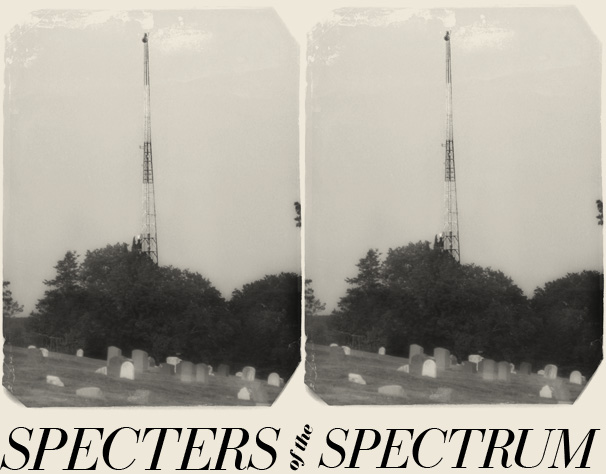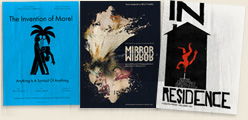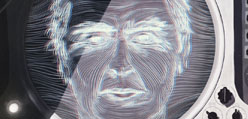The ambient hum of soft white noise and winding magnetic tape fill the observation room, but it does not deter the focus of Dr. Konstantin Raudive, who is quite aware that he is engaged in a “hazardous venture.” Tonight, he will communicate with the most captive audience of all: the dead.
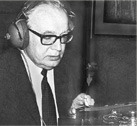
There is a second level: that of the psychical-spiritual being.
Raudive, 57, presides over a spare operating table with a microphone and a medium wave radio tuned to an empty frequency. Both objects feed neatly into a reel-to-reel tape recorder.
At that moment on February 4th, 1966, Raudive was perhaps musing over his own mortality and the radical changes that had taken place in the years before. The field of psychology had made a departure from the philosophical leanings of his mentor, Carl Jung, into the realm of the hard sciences. Empiricism! Tucked away from the sleepy German winter, Raudive would have to get hard proof to silence the skeptics.
A visit from Professor Hans Bender earlier in the evening has put Raudive’s nerves on edge. The Professor is certain that his colleague, in an act of unconscious projection, has simply been fishing words out of the sonic refuse. This was a case of “mediumistic psychoses,” Bender said — the same way one could mentally alter the lyrics to Schubert Lieder by concentrating just so. Solemnly aligned with his convictions, Raudive begins to review one of his tapes. A faint voice speaks in Raudive’s native Latvian tongue:
“Why are you raging, Konstantin?... Don’t convince Professor Bender! ... To convince his colleague with Schubert-Lieder texts will not succeed. You cannot sleep yet, Konstantin. A great responsibility — to lift the curtain. Do not doubt! — “To lift the curtain is your duty, Kosti, your duty is to lift the curtain. Keep it to yourself! Keep it yourself, keep it for yourself...” from Breakthrough: An Amazing Experiment in Electronic Communication With the Dead, 1971.
It would be the beginning of one of his most productive periods. From the summer of 1965 to the fall of 1968, Raudive claimed to have recorded over 72,000 instances of Electronic Voice Phenomena (EVP). Many of his findings were collected in his 1968 book Unhoerbares Wird Hoerbar (“The Inaudible Becomes Audible,” published in English as Breakthrough: An Amazing Experiment in Electronic Communication With the Dead, 1971). Raudive was inspired to begin his investigation after reading Voices From Space (1964) by Friedrich Jurgenson. Jurgenson, a painter and film director from Odessa by way of Sweden, discovered EVP by accident while attempting to record bird songs in his garden. Raudive was so enthralled by the questions raised in Jurgenson’s book, especially those concerning his lifelong preoccupation with life after death, that he immediately requested Jurgenson’s company so that he could witness the technique firsthand.
Though Raudive eventually became the most visible proponent of EVP practices, he was hardly the first member of the scientific community to inquire into the metaphysical potential of sound reproduction. Nikola Tesla, upon receiving mysterious transmissions from his radio tower in Colorado in 1898, speculated that the signals were a form of interplanetary communication. Even Thomas Edison described the potential to invent an instrument of such delicate and sensitive nature that it would be capable of recording the movements of ethereal bodies. While these brazen theories now conjure images of wide-eyed visionaries pondering the most far-fetched potential of young technologies, their suppositions are not completely ungrounded. If the soul, or “personality” as Edison preferred, were to survive the body’s demise, then its presence would theoretically produce a vibration. If a method were devised to “hear” these obscured facets of our resonant world, then the dead might once again chatter among the living.
Raudive’s prolific transcriptions of voices from the beyond, while often cryptic and disjointed, read like a fever-dream version of The Spoon River Anthology. The cast of characters alone is a roll call of the 20th century’s most notable figures. In Raudive’s netherworld, Hitler is disliked by his neighbors for producing counterfeit money (“Hitler is no example here.”) and constantly referring to himself in the third person (“Greetings, first you must have a sense of humor. Here is Major Hitler. Honor Hitler a little!”). Stalin is always on the go (“Terribly hot. Terrible hurry.”), Nietzsche giggles incessantly, and Dostoevsky doles out career advice (“Nonsense! You shall paint on Friday.”). Throughout hours of recording, Raudive holds court with everyone from Churchill to Lenin and Goethe to Lorca. Many of the ghostly whisperers were adamant that Raudive remain steadfast and dedicated to his experiments despite the criticism that swirled in the wake of his findings.
Only a small sampling of these recordings were made public for listening purposes; a short flexi-disc record, stuck in the sleeve of Breakthrough, highlights Raudive’s “greatest hits.” The audio features tiny warbles fighting through thick distortion and voices speaking at twice their normal speed, but their cadence is unmistakably human. The dead speak in “short, telegram-style” sentences or fragments with a pulsating rhythm that the doctor believed was “forced on them.” Raudive said that this truncated manner of speech accounted for the dead’s disregard for grammar and frequent use of neologisms, qualities that make the messages all the more cryptic and obscure to the casual listener. On top of this confusion, the voices also sometimes make use of five or six different languages in a single sentence. Curiously enough, the vast majority of languages spoken fall under the umbrella of Raudive’s personal fluency, but the doctor rejected the idea that this was anything more than a coincidence. He insisted that the muddled linguistic amalgamations were caused by haphazard translations of otherworldly energies:
“...does a thought consist of words? — The answer is: no. Thoughts consist of psychic particles that stand in the same relation to reality of words. As we all know, there are many forms of language: the language of the battlefield, the language of reports, the language of every-day life, an ex-cathedra-language and so forth. This means that to think of a language form is to think of a form of life.”
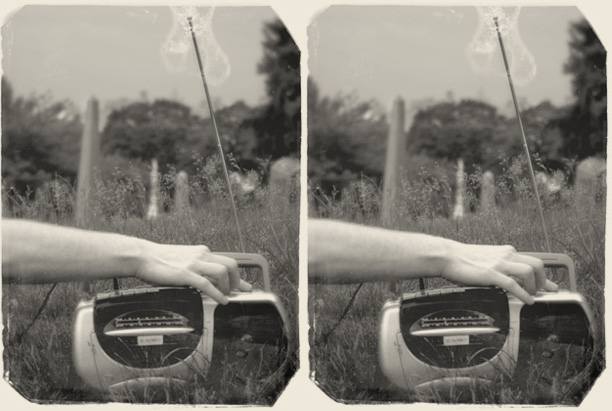
Ironically enough, it was this fragmentary manner of speech that would cause Raudive’s work to find greater resonance among artistic circles than within any quantitative field of science.
In William S. Burrough’s essay “It Belongs to the Cucumbers,” named after one of the more enigmatic “voice-text” entries in Breakthrough, the author cites Raudive’s recordings as an appropriate addition to Kerouac’s school of Disembodied Poetics and an inspiration for his own “cut-up” tape experiments. Burroughs draws a link between Raudive’s voices and both schizophrenic speech and dream utterances, forms of communication that display a juxtaposition of seemingly disordered text, where meaning becomes a subjective experience. The concept was not new; Surrealists, Dadaists, and Futurist artistic factions had all toyed with the idea of collage and decoupage in literary and artistic forms, but Burroughs was focused on applying this technique to sound reproduction. By cutting up, looping, and re-copying passages of audio, much like Raudive had done to hone in on suspected instances of EVP, Burroughs found he could create new meanings. “I have gotten words and voices from barking dogs,” mused Burroughs. “No doubt one could do much better with dolphins.” Burroughs, like Professor Bender, was inclined to believe that the voices were more akin to the “overflow pipes of the unconscious,” but he also found value in the technique’s ability to alter present realities. “Everything is recorded, and if it is recorded, it can be edited,” the writer once told Throbbing Gristle/Psychic TV frontman/woman Genesis P-Orridge, a mantra s/he and other post-modern artists would use as justification for upending the conventional artistic process. One man’s divine revelation had become another man’s genesis of invention.
In fact, it was Raudive’s spiritualistic framing of EVP that led to its dismantling by the wider scientific community. Proving the manifestation of unidentified voices on tape is one thing, but to assert that these voices belonged to those of human ghosts required a leap of faith. The central thesis of Breakthrough not only supposes the existence of a spectral ether, but it also fundamentally augments the theory of relativity:
My research has led me to the personal conclusion that apart from the biological-psychical level on which we human beings here exist, there is a second level: that of the psychical-spiritual being, whose potentialities are only released after death. This psychical-spiritual being tries to build a bridge between its world and that of our earthly form of life, and it endeavours on its own initiative to make contact in order to guide those on earth into a new reality.
Raudive was adamant that his comprehensive research would remove all doubt about the existence of an alternate plane, but it was eventually the either/or mentality of his approach that discredited his findings. He had ruled out the possibility that the voice manifestations were a product of extraterrestrial communication because the content was “too banal.” Burroughs responded: “No reason to think we have a monopoly on banality.” The possibility that the radio recordings were capturing stray signals from other stations was also dismissed because of the isolated laboratory conditions. Raudive viewed the technology of radio and tape recorders as precise instruments, ignoring the fact that taping and re-copying transmissions did not provide an exact replica of the original, but instead a manipulation.
Following the publication of Breakthrough, a number of follow-up experiments were performed by reputable psychological journals as well as sound recording experts.1 Many of these experiments were successful in capturing samples with an inexplicable vocal presence, but when the voice-texts were tested among a wide range of listeners, the readings differed widely in interpretation. Perhaps most embarrassingly, when one of Raudive’s most prized EVP samples was played to a test audience, they were clearly able to identify its content: a German Easter Sunday broadcast that had aired on the same date that Raudive had made his recording. One of the main faults in Raudive’s methodology was that he had taken as a given the very thing he was trying to prove. Raudive was looking for confirmation, the scientists sneered, and his imagination had run wild.
In 1974, six years after the publication of Breakthrough, Raudive was laid to rest in South Germany. His grave was adorned with a chunky rough-faced tombstone inscribed with a fitting epitaph: Death — Transition to a new Being. Of the myriad of questions left unanswered with his passing, the most confounding question for some was the roots of Raudive’s obsession. Why did the doctor find it so necessary to not just ponder the mysterious origins of his recordings, but to confirm beyond all doubt their significance? Investigations into Raudive’s past reveal only scraps of information that mirror the enigmatic parsing of the voice-texts. Years of academic study across Europe, the penning of two novels focused on the afterlife, and a love affair with his colleague and co-experimenter Dr. Zenta Maurina shed little light on a perplexing life. Raudive was a devout Catholic, and by having reputable Church officials witness the experiments in Breakthrough, he was at least granted the satisfaction of having his work endorsed by the ecclesiastical heavies.2 Another point to note is the frequency of Raudive’s mother on the recordings. In her “transmissions,” she comes across as a strong-armed matriarch prodding her son to finish his experiments and criticizing his manners and appearance.
Pinning the cause on a combination of religious guilt and morbid fascination, one could reasonably assume that Raudive wanted a second chance, an ability to rationalize the threat of looming mortality. By all accounts, however, his driving force was not in to proving his truth, but in demonstrating how “circumscribed our senses really are.” Our world was small when it should be large, Raudive thought, and the popularity of psychoanalytic theory infuriated him. Why should Freud’s reductionist theories be accepted without challenge when there is still so much about our world left to explore? What Raudive was grasping at in those sonic splinters was the need to break past limitations, to “lift the curtain” on what he felt was a narrow-minded perspective developing in human thought. Dr. Konstantin Raudive was a most unlikely cock-eyed optimist, a sentiment echoed by reports issued by his dedicated followers nearly a decade later. Heard over a clock radio was Raudive’s voice, speaking from the afterworld: “Soon it will work everywhere!.... Here it is summer, always!”
Author’s note:
Since Raudive included detailed notes on how to recreate the EVP experiments, I figured my research would be incomplete if I did not attempt my own electronic communication with the dead.
Armed with a mono boombox, I headed to Greenwood Cemetery on Memorial Day weekend with another Moon correspondent, who served as both witness and photo-documentarian for our auditory séance. I tuned the radio to the station with the least interference on the entire FM band and began recording onto a blank audiocassette. Prefacing was necessary, so I delivered a short speech admitting my skepticism, but sincerely stating I would keep an open mind. The results were startling; Even though I had been monitoring the recording on headphones for almost the entirety of our 30-minute session, the tape only contains only a few minutes of actual sound. The audio begins with the predictable wave of white noise, then without warning, the sound wave virtually flatlines. Right before this unpredictable shift, a very alien noise occurs, absolutely distinct from the distortion that precedes it:
I slowed down the tape, just as Raudive did, and zeroed in on the disturbance:
Maybe my unconscious pipes were are just overflowing, but I can’t help but hear three syllables uncannily similar to the surname of a certain Latvian parapsychologist. Perhaps old Konsti wants to “keep it to himself?”
- Studies were conducted by D.J. Ellis and E.L. Smith for the Journal of the American Society for Psychical Research (1974, 1975), J. Keil for the European Journal of Parapsychology (1980) and Ken Atwood, chief sound engineer for Pye records Ltd, who stated after his study, “I have done everything in my power to break the mystery of the voices without success; the same applies to other experts. I suppose we must learn to accept them.” (1971) ↩
- The Rt. Rev. Mgr. Prof. Dr. Charles Pfleger, Catholic philosopher and theologian, remarks in the appendices to Breakthrough that due to Raudive’s work “dogma is being looked at with fresh eyes to-day, and quite fundamental articles of faith are under review.” ↩

